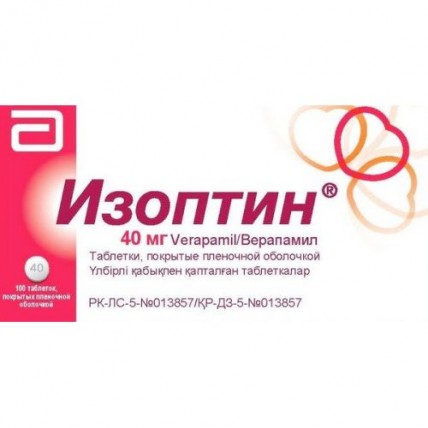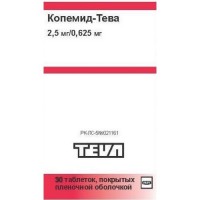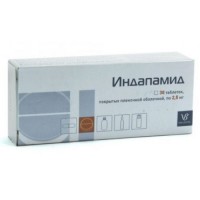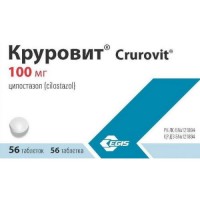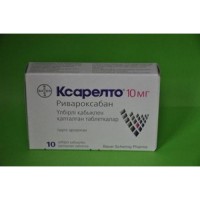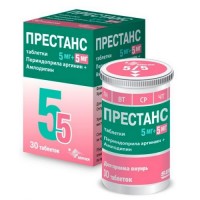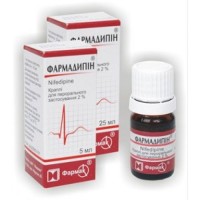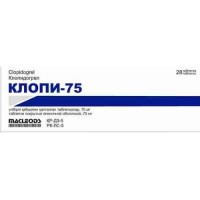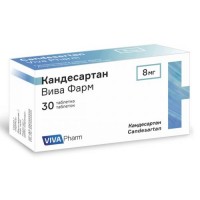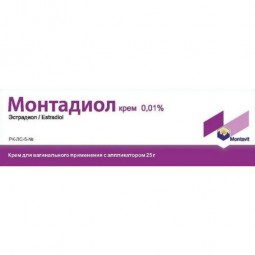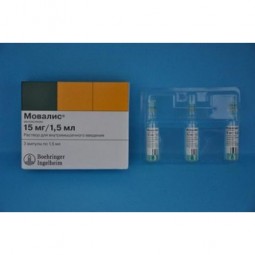ISOPTIN® (Verapamil HCI) 40 mg, 100 coated tablets
- $18.70
Composition
One tablet contains the active ingredient - Verapamil Hydrochloride 40 mg
excipients: calcium dihydrogen phosphate dihydrate, microcrystalline cellulose, anhydrous colloidal silicon dioxide, croscarmellose sodium, magnesium stearate,
shell composition: hypromellose, sodium lauryl sulfate, macrogol 6000, talc, titanium dioxide (E 171).
Pharmacological properties
Pharmacokinetics
Verapamil is rapidly and almost completely absorbed in the small intestine. The absorption rate is 80–90%. Plasma protein binding - 90%. Bioavailability - 10-20%.. The maximum plasma concentration is achieved in 1-2 hours after taking the drug. Due to the extensive metabolism of verapamil, a large number of metabolites are formed. Of the metabolites, only norverapamil is pharmacologically active (approximately 20% of the hypotensive activity of verapamil). The half-life is 3-7 hours for a single dose and 4.5-12 hours for a course administration. Verapamil and its metabolites are excreted mainly through the kidneys; only 3-4% is excreted unchanged. Up to 16% of the drug is excreted in feces.
There is no difference in the pharmacokinetics of verapamil in people with healthy kidneys and in patients with end-stage renal disease. The half-life is increased in patients with liver cirrhosis due to low clearance and high volume of distribution.
Pharmacodynamics
Verapamil, the active ingredient of Isoptin®, blocks the transmembrane flux of calcium ions in the cell of the heart and vascular smooth muscles. It directly reduces myocardial oxygen demand by influencing the energy-consuming metabolic processes in myocardial cells and reducing afterload. By blocking the calcium channels of the smooth muscles of the coronary arteries, blood flow to the myocardium increases, even in postischemic areas, and the spasm of the coronary arteries is relieved. These properties determine the anti-ischemic and antianginal efficacy of Isoptin® in all forms of coronary heart disease.
The antihypertensive efficacy of Isoptin® is due to a decrease in peripheral vascular resistance without an increase in heart rate as a reflex response. No undesirable changes in the physiological values of blood pressure are observed.
Isoptin® has a pronounced antiarrhythmic effect, especially in supraventricular arrhythmias. It delays the conduction of the impulse in the atrioventricular node, as a result of which, depending on the type of arrhythmia, the sinus rhythm is restored and / or the ventricular rate is normalized.
Indications for use
- ischemic heart disease: stable exertional angina, unstable angina (progressive angina, rest angina), vasospastic angina (variant angina, Prinzmetal's angina), postinfarction angina in patients without a heart attack, if b-blockers are not indicated
- rhythm disturbances: paroxysmal supraventricular tachycardia, atrial flutter / fibrillation with rapid atrioventricular conduction, with the exception of Wolff-Parkinson-White (WPW) syndrome
- arterial hypertension
Method of administration and dosage
Doses are selected individually for each patient. The drug should be taken without dissolving or chewing with a sufficient amount of liquid (for example, a glass of water, in no case grapefruit juice), preferably during or immediately after a meal.
Adults and adolescents weighing more than 50 kg:
Ischemic heart disease, paroxysmal supraventricular tachycardia, atrial flutter / fibrillation:
The recommended daily dose is 120-480 mg, divided into 3-4 doses. The maximum daily dose is 480 mg.
Arterial hypertension
The recommended daily dose is 120-360 mg, divided into 3 doses.
Application in pediatrics (only for cardiac arrhythmias):
Children 6-14 years old 80-360 mg per day divided into 2-4 single doses.
Elderly patients.
Elderly patients may be more sensitive to the action of verapamil hydrochloride when using the usual dose for adults, the dose may be reduced for potoemu.
Liver dysfunction
In patients with limited liver function, depending on the severity, the effect of verapamil hydrochloride is enhanced and prolonged due to a slowdown in the disintegration of the drug. Therefore, in such cases, the dosage should be set with extreme caution and start with small doses (for example, for patients with limited liver function, first 2-3 times a day 40 mg, respectively 80-120 mg per day).
After prolonged therapy, the drug should be discontinued, gradually reducing the dose.
The duration of treatment is determined by the doctor. The course of treatment is not limited.
Side effects
Adverse events are classified by frequency of occurrence: very often> 10%, often> 1% - <10%, sometimes> 0.1% - <1%, rarely> 0.01% - <0.1%, very rarely> 0 , 01%, including special cases.
Often
- bradycardia, Atrioventricular blockade of I, II or III degree or bradyarrhythmia with atrial fibrillation, arterial hypotension / hypotension, sinus node arrest, asystole
- nausea, flatulence, constipation
- dizziness, headache
Sometimes
- development or exacerbation of heart failure, a significant decrease in blood pressure and / or orthostatic reactions
- impotence, erectile dysfunction, gynecomastia
- galactorrhea
- decreased glucose tolerance
Rarely
- vomiting, abdominal discomfort
- allergic reactions (erythema multiforme, pruritus, urticaria, maculopapular rash), bronchospasm, accompanied by itching and urticaria
- alopecia
- erythromelalgia
- myalgia, arthralgia, muscle weakness
- tachycardia
Very rarely
- palpitations, peripheral edema, hot flashes
- abdominal pain, intestinal obstruction
- headache, nervousness, dizziness, drowsiness, fatigue, sensory disturbances (ringing in the ears, paresthesia, neuropathy and tremor, extrapyramidal syndrome, sweating, erythema polyformis, skin redness and feeling of heat)
- hemorrhages in the skin or mucous membranes (purpura), photodermatitis
- gingival hyperplasia (gingivitis and bleeding), which disappears after drug withdrawal, allergic hepatitis
- increased levels of liver enzymes and blood prolactin levels
In single cases
- in elderly patients with long-term therapy, gynecomastia developed, which completely disappeared after discontinuation of the drug
- angioedema, Stevens-Johnson syndrome
- hypersensitivity
Contraindications
- cardiogenic shock
- acute myocardial infarction with complications (bradycardia, hypotension,
left ventricular failure)
- severe conduction disturbances (sinoatrial or atrioventricular block II and III degree)
- sick sinus syndrome, (if an artificial pacemaker is not implanted)
- known hypersensitivity to verapamil or to any component of the drug
- chronic heart failure IIB - III st
- atrial flutter / fibrillation and the presence of additional pathways (WPW syndrome, LGL syndrome) - risk of ventricular tachycardia
During treatment with Isoptin, do not use intravenous beta-blockers at the same time (with the exception of intensive care).
Drug interactions
Verapamil is a substrate and inhibitor of cytochrome P450 3A4. With the simultaneous administration of simvastatin, which is metabolized through cytochrome P450 3 A4, verapamil can increase the level of simvastatin in the blood.
Antiarrhythmics, beta-blockers, inhalation anesthetics:
Mutual enhancement of cardiovascular effects (high-grade atrioventricular block, significant decrease in heart rate, induction of heart failure, significant decrease in blood pressure). During treatment with the drug, do not simultaneously use intravenous beta-blockers (with the exception of intensive care).
Antihypertensive drugs, diuretics, vasodilators: increased antihypertensive effect.
Prazosin, terazosin: additional antihypertensive effect.
Antiviral (HIV) drugs: Plasma concentrations of verapamil may rise. Prescribe with caution, it may be necessary to reduce the dose of verapamil.
Digoxin, digitoxin: Increased plasma digoxin levels caused by decreased renal excretion. Particular attention should be paid to the symptoms of overdose with digoxin / digitoxin and, if necessary, reduce the dose of glycoside.
Cimetidine: the area under the concentration-time curve increases, the clearance of verapamil decreases.
Quinidine: an increased decrease in blood pressure is possible. Patients with hypertrophic obstructive cardiomyopathy may develop pulmonary edema. Increased plasma quinidine levels.
Carbamazepine: increased carbamazepine levels, increased neurotoxic side effects of carbamazepine, diplopia, headache, ataxia, dizziness.
Lithium: Increases the neurotoxicity of lithium.
Antidiabetic drugs (glyburide): increases the Cmax of glyburide by approximately 28%.
Rifampicin: weakening the hypotensive effect.
Erythromycin, telithromycin: Possible increase in verapamil levels.
Colchicine: Combination with verapamil is not recommended due to increased colchicine exposure.
Muscle relaxants: Potential enhancement of action.
Acetylsalicylic acid: increased bleeding.
Doxorubicin: with the simultaneous use of doxorubicin and verapamil orally increases the bioavailability and maximum plasma doxorubicin levels in patients with small cell lung cancer. In patients in the stage of a progressive tumor, significant changes in the pharmacokinetics of doxorubicin with simultaneous intravenous use of verapamil are not observed.
Almotriptan: the area under the concentration-time curve increases, Cmax increases.
Phenobarbital: increases the clearance of verapamil.
Sulfipyrazone: there may be a decrease in the hypotensive effect.
ethanol: the breakdown of ethanol is delayed and the level of ethanol in plasma increases, thereby verapamil enhances the effect of alcohol.
HMG-CoA reductase inhibitors:
Treatment with HMG-CoA reductase inhibitors (simvastatin, atorvastatin, lovastatin) in patients taking verapamil should start with the lowest possible dose. If a patient who is already taking verapamil needs an HMG-CoA reductase inhibitor (simvastatin, atorvastatin, lovastatin), consider the need to reduce the dose of statins and titrate against the background of plasma cholesterol concentration.
Grapefruit juice: the area under the concentration-time curve increases, the Cmax of verapamil increases.
St. John's wort: the area under the concentration-time curve decreases with a corresponding decrease in Cmax.
Immunological drugs (cyclosporine, everolimus, sirolimus, tacrolimus): levels of these drugs may increase.
Interaction based on cytochrome P450 isoenzyme 3A4.
Verapamil hydrochloride is metabolized in the liver by cytochrome P450 isoenzyme 3A4 and inhibits this enzyme.
In this regard, attention should be paid to the following interactions:
Other inhibitors of the cytochrome P450 isoenzyme 3A4, such as azole fungicides (such as clotrimazole or ketoconazole), protease inhibitors (such as ritonavir or indinavir), macrolides (such as erythromycin or clarithromycin), and cimetidine: an increase in verapamil hydrochloride plasma and cimetidine: / or the plasma level of these drugs is due to the effect on their metabolism.
Inducers of cytochrome P450 isoenzyme 3A4, such as phenytoin, rifampicin, phenobarbital, carbamazepine: lowering the plasma level of verapamil hydrochloride and weakening the effect of verapamil hydrochloride.
Substrates of cytochrome P450 isoenzyme 3A4, for example, antiarrhythmics (for example, amiodarone or quinidine), CSE inhibitors (for example, lovastatin or atorvastatin), midazolam, cyclosporine, theophylline, prazosin: increased plasma levels of these drugs.
Special instructions
Verapamil should be used with caution in patients:
- with AV block of the 1st degree;
- with arterial hypotension (systolic blood pressure <90 mm Hg);
- with bradycardia (heart rate less than 50 beats per minute);
- with severe liver failure;
- with disorders of neuromuscular conduction (myasthenia gravis, Eaton-Lambert syndrome, progressive Duchenne muscular dystrophy).
During the use of the drug, you should avoid eating food and drinks with grapefruit. Grapefruit may increase plasma levels of verapamil hydrochloride.
Application during pregnancy and lactation
The drug should not be taken during the first and second trimesters of pregnancy. Reception in the third trimester of pregnancy only in case of emergency, when the result outweighs the risk to the mother and child, and should not be taken during breastfeeding, since the biologically active substance penetrates into breast milk.
The ability to influence the reaction rate when driving vehicles or other mechanisms.
Depending on the individual reaction, the ability to drive vehicles or work with mechanisms may be impaired. This is especially true of the initial phase of treatment, when changing the antihypertensive drug, as well as while taking the drug with alcohol.
Overdose
Symptoms depend on the amount of drug taken, the time the detoxification measures were taken, and the age of the patient.
Symptoms: a significant decrease in blood pressure, heart rhythm disturbances (bradycardia, borderline rhythms with atrioventricular dissociation and high-grade atrioventricular block), which can lead to shock and cardiac arrest; clouding of consciousness to a coma, stupor, hyperglycemia, hypokalemia, metabolic acidosis, hypoxia, cardiogenic shock with pulmonary edema, renal dysfunction and seizures.
Treatment is aimed at removing the substance from the body and restoring the stability of the cardiovascular system.
General measures: gastric lavage is recommended even if more than 12 hours have passed since the drug was taken and gastrointestinal motility is not detected (absence of intestinal murmurs). Common resuscitation measures include chest compressions, artificial respiration, defibrillation, and pacing. Hemodialysis is not indicated. Hemofiltration and possibly plasmaphoresis may be beneficial (calcium antagonists bind well to plasma proteins).
Special measures: elimination of cardiodepressive influences, hypotension and bradycardia. A specific antidote is calcium: 10-20 ml of 10% calcium gluconate solution (2.25-4.5 mmol) is injected intravenously. If necessary, you can repeat the administration or carry out an additional drip infusion (for example, 5 mmol / hour).
Additional measures: for AV block II and III degrees, sinus bradycardia, cardiac arrest, atropine, isoproterenol, orsiprenaline or cardiostimulation
In case of hypotension as a result of cardiogenic shock and arterial vasodilation, dopamine (up to 25 μg / kg / min), dobutamine (up to 15 μg / kg / min), or norepinephrine are used. Serum calcium concentrations should be in the upper normal range or slightly higher than normal. In connection with vasodilation in the early stages, a replacement fluid (Ringer's solution or saline) is introduced.
Storage conditions
Store at a temperature not exceeding 25 ° C.
Keep out of the reach of children!
Shelf life 5 years
Do not use the drug after the expiration date indicated on the package.
